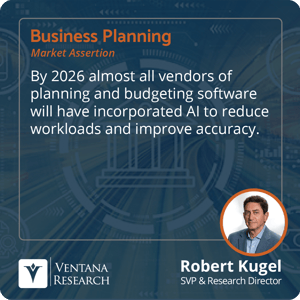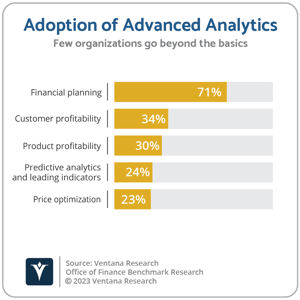Tap Into AI To Do More by Doing Less
Doing more by doing less means using artificial intelligence and related technologies to make financial planning and analysis organizations more productive. By eliminating low-value and unproductive work, AI enables FP&A teams to free up considerable time for more useful and consequential forecasting, planning, budgeting, analysis and reporting.
AI isn’t some far-off capability. It’s already available to varying degrees in planning and budgeting platforms. The scope, complexity and depth of AI functionality will grow steadily over the next five years. Planning software vendors are incorporating an integrated data store necessary for machine learning to support AI. This type of data store will all but eliminate time spent on data preparation tasks that occupy considerable analyst time.
over the next five years. Planning software vendors are incorporating an integrated data store necessary for machine learning to support AI. This type of data store will all but eliminate time spent on data preparation tasks that occupy considerable analyst time.
Moreover, generative AI will further boost productivity by creating first drafts of annotations and narrative text, substantially cutting the time spent on these tasks. By giving time back, AI-enabled planning applications will allow FP&A to take on a more strategic role built on tools that extend planning and analysis capabilities. Ventana Research asserts that by 2026, most vendors of planning and budgeting software will incorporate AI to reduce workloads and improve accuracy.
Artificial intelligence using machine learning involves the application of data science-derived algorithms that include the capability to “learn” and, therefore, change to achieve better results as more data is collected and more outcomes are observed. Additionally, AI applies ML algorithms, often in a way that mimics how a human might respond to or manage a process. Combined, the two make it possible to have computer systems that adapt to the needs of an organization without requiring a custom deployment process that imposes rigidity over time.
Doing a quick survey of current vendor offerings reveals a list of AI-enabled capabilities, including:
- Anomaly detection that alerts planners if the value entered is not aligned with historical results, inconsistent with top-down guidance or suspect for other reasons.
- Unconstrained demand plans are generated at a desired level of granularity that considers seasonality, promotions, events and external factors.
- Driver-based forecasting that aligns sales, labor, material costs and inventory.
- Detailed cash management built on forecast changes in working capital, operating cash flow and investments while respecting legal entity, currency and location constraints.
- Conversational analytics that enable people to have a dialog with the numbers to understand the meaning behind them.
- Automated annotations and storytelling.
Not all of these features are available from every vendor, and it’s likely that many improvements will be made to these offerings over the next five years.
Coming right behind those advances are more sophisticated capabilities that should be readily available within three to five years. One that can radically alter the business planning process is autogenerating a detailed first draft of an integrated operating and financial plan for each business unit owner. The model will consider existing plans, other plans in the organization and changes in expected external factors such as markets, pricing and economic conditions.
It’s important to note that, from a trust perspective, the objective will be for AI to create a plausible first draft to speed up planning cycles so that, say, monthly revisions can be done in minutes rather than hours and days. Assisting in accelerating the process of creating or revising plans will be AI-powered, cell-level goal-seeking that takes into account trade-offs and constraints. Analytics can identify key drivers and key performance indicators that build and revise forecasting models, while ongoing machine learning continuously assesses results to identify changes in drivers. What AI will not do is eliminate the time that executives and business unit owners spend wrangling resources and haggling over sandbagged forecasts.
Another example of using AI in business forecasting is demand planning with constraints, which is a more realistic method compared to unconstrained plans. AI provides a greater scope of automated, on-demand performance analytics, including a rank-ordering of factors that drove results so managers can focus on the most consequential levers to improve performance. Analytics are built in to identify where plans are not well coordinated. Tax planning identifies potential strategies to reduce long-term tax expense. And generative AI speeds up report production, including regulatory filings.
Predictive analytics is one immediate benefit of applying machine learning to forecasting and planning. This is an essential discipline for finance departments and is increasingly embedded in planning applications. Although the technology has been available for decades, our Office of Finance Benchmark Research finds that just 24% of organizations use it extensively in daily operations.
embedded in planning applications. Although the technology has been available for decades, our Office of Finance Benchmark Research finds that just 24% of organizations use it extensively in daily operations.
Organizations can use predictive analytics to achieve better results. It can create more accurate and nuanced projections of future outcomes on a line-by-line basis – for example, projecting monthly or weekly demand for product families or individual stock-keeping units. The prediction can incorporate past results as well as trends in demand and new product introductions, along with seasonal patterns, planned marketing campaigns and even the impact of calendar holidays, such as Easter, the Lunar New Year and the length of time between the U.S. Thanksgiving and Christmas.
Besides forecasting, predictive analytics is especially useful in generating timely alerts when results show meaningful divergences from expectations. For instance, rather than having to wait until the end of the month to review results and initiate a course of action, an enterprise would get a heads-up when revenues from a particular product or channel are falling short of expectations. By spotting it early, managers can, for example, alter sales incentives or adjust manufacturing schedules. If demand exceeds expectations because of a promotion, businesses can increase production and accelerate shipments to avoid stock-outs. In this context, rather than being a “black box” that expects obedience without understanding, predictive analytics can present executives and managers with a range of possible responses to a specific business condition along with potential outcomes and an assessment of their probability.
AI capabilities by themselves are insufficient. Machine learning and predictive analytics require timely, accurate and relevant data. For that reason, business planning vendors now incorporate data stores to support continuous testing and training of models. I use the term “data pantry” (somewhat tongue in cheek) to describe this type of data store that’s part of a business application platform created for a specific set of users and use cases. It’s a data pantry because, unlike a general-purpose data store such as a data warehouse or data lake, everything the user needs is readily available and easily accessible, with labels that are immediately recognized and understood.
The key benefits of unified data include:
- Eliminating data preparation, which is a major time-saver. Our Analytics and Data Benchmark Research reveals that individuals spend a considerable amount of time preparing data for analysis and reviewing it for quality and consistency – activities that are no longer necessary when a data pantry is available.
- Broadening the depth and scope of reporting and analysis.
- Making it possible for software providers to curate a useful set of external data to promote accuracy in predictive analytics and forecasting.
- Supporting the efficient training of machine learning models.
- Enabling real-time, on-demand self-service reporting and dashboards to inform decision-making.
Rather than putting robots in charge of finance and accounting departments, AI will eliminate the robotic work that today consumes considerable amounts of time for FP&A professionals while providing them with tools to fulfill a more consequential role in the enterprise. FP&A leaders must consider how to evolve their role and execute the change management program necessary to make this happen. Their mission for the rest of the 2020s will be to make planning and budgeting faster and easier for business leaders.
Enterprises that are using a dedicated planning application should stay on top of vendors’ AI roadmap and consider how existing and scheduled capabilities can enhance productivity and the business value of planning and budgeting. Consider using each vendor’s customer success organization to facilitate AI adoption. Organizations using stand-alone spreadsheets for budgeting and planning should consider a dedicated application and adopting Integrated Business Planning. Our Business Planning Buyers Guide can help identify the vendor that best meets organizational requirements.
Regards,
Robert Kugel
Authors:

Robert Kugel
Executive Director, Business Research
Robert Kugel leads business software research for Ventana Research, now part of ISG. His team covers technology and applications spanning front- and back-office enterprise functions, and he personally runs the Office of Finance area of expertise. Rob is a CFA charter holder and a published author and thought leader on integrated business planning (IBP).










